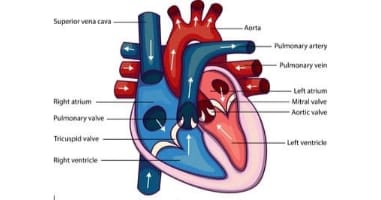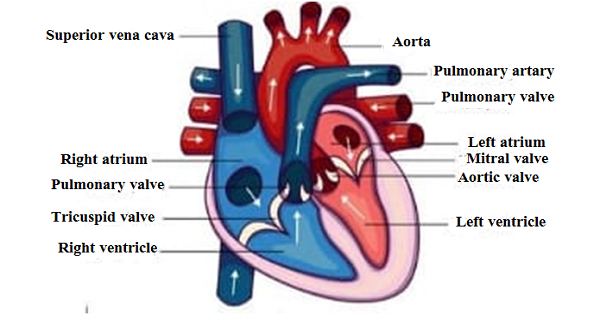The structure and anatomy of the heart
The heart is a muscular organ that is as big as our fist, the heart is located just behind and slightly left of the breast bone. The heart works like a pump, It pumps blood through the network of arteries and veins.arteries.veins and heart all together are called the transportation system of our body, because nutrients, water, oxygen, and carbon dioxides are transported through the blood. Since Co2 and O2 are transported through the heart so it is designed to have four chambers.
The heart gets deoxygenated blood from all parts of the body and pumps out oxygenated blood to all parts of our body.
The heart has different chambers to prevent the oxygen-rich blood from mixing with the blood containing carbon dioxide.
You can study how does the heart function through a step by step way.
1. Oxygen-rich blood from the lungs comes to the thin-walled upper chamber of the heart on the left, the left atrium.
2. The left atrium dilates when it is collecting the blood from the lungs. The left atrium then contracts while next chamber, the left ventricle expands so that the blood is transferred into it.
3. The left ventricle then contracts and thus blood is pumped out to all body parts.
4. Deoxygenated blood comes from the body to the upper chamber on the right, the right atrium.
5. Right ventricle receives the deoxygenated blood through a valve from the right atrium and then sends it to the lungs through the pulmonary artery for oxygenation of blood.
Click for online shopping
Future Study Point.Deal: Cloths, Laptops, Computers, Mobiles, Shoes etc
You can also study
Human reproductive systems of Male & Family
Human digestive system structure and function
Modes of reproduction used by single organisms-Asexual reproductions
The structure and anatomy of the Heart
Anatomy of the Human brain-Class 10 CBSE
NEET Sylabus and its preparation
Structure Of Heart
The heart is made up of three layers of cardiac tissue
- Epicardium
- Myocardium
- Endocardium
These layers are surrounded by the pericardium a thin outer lining protecting the heart. The two small upper chambers are atriums and the two larger lower chambers are the ventricles, there left and right sides of the heart are separated by a wall of muscle known as the septum.
The mechanism of the heart
The right atrium receives deoxygenated blood from the veins, vena cava from the upper and lower parts of the body, and then pumps it to the right ventricle.
The right ventricle receives blood from the right atrium and pumps it to the lungs through the pulmonary artery
The left atrium receives the oxygenated blood from pulmonary veins. The right ventricle receives blood from the left atrium.,The right ventricle which is the strongest chamber of the heart creates our blood pressure due to vigorous contractions.
The right ventricle sends oxygen-rich blood to all parts of the body through the aorta. the biggest artery of the circulatory system.
Please follow us on Pinterest
Q-How Does The Exchange Of Gas Takes Place In Fishes?
Ans. Fishes have only two chambers to their hearts and the blood is pumped to the gills, is oxygenated there, and passes directly to the rest of the body. Thus, blood goes only once through the heart in the fish during one cycle of passage through the body.
Q-Why does not oxygenated blood and deoxygenated blood mix together in blood vessels or in the heart?
Ans. The oxygenated blood is received by the left atrium through the pulmonary vein then it is sent to the left ventricle through a valve that maintains the unidirectional flow of blood then it is pumped out through the biggest blood vessel aorta . Deoxygenated blood is received by the right atrium and then it is sent to the right ventricle through a valve between them making the one-directional flow of the blood. The left and right part of the heart is separated by a muscular layer known as the septum that prevents the mixing of blood. The base of the pulmonary vein, pulmonary artery, and aorta is connected to the chambers of the heart through the valves that prevent backflow of the current.
Important Science Notes for Class 9 and 10 grade
Class 10 CBSE Science Notes
Class 10 Biology Viva Voce Questions and Answers for CBSE Board 2020-21
Class 10 chemistry Viva Voce Questions and Answers
Class 10 Physics Viva Voce Questions and Answers
Class 10 Chemistry Practical Based Questions and Answers
What are the physical and chemical properties of metals?
Type of Chemical Reactions with Complete detail
Chemical properties of Acids and Bases-A note for grade 10 students
What is pH value and its importance in everyday life.
Ozone Layer and How it is Getting depleted.
Myopia, Hypermetropia and Presbyopia
Human eye structure and its function
Electrical resistance and conductance
Electric Current and Heating effect of Electric Current
What is a potential difference across an electric field ?
Myopia, Hypermetropia and Presbyopia
Difference between soaps and detergents
Why do the star twinkle but planets don’t
Light reflection, refraction, scattering, and dispersion
Extraction of metals as per the activity series
Ionic and covalent compounds and the difference between them
Food chain and food web in an ecosystem
Class 9 CBSE Science Notes
Three Laws of Motion: Class 9 CBSE
Evoporation,Vapourization and Latent heat -Class 9 CBSE notes
What is an atom,molecule and atomicity of a substance?
How to determine Valency,net charge of an ion and Molecular formula of a substance.
Thrust and Pressure : Difference
The Complete Detail of Archimedes Principal
Average Speed and Average Velocity: Differences
How to evaluate recoil velocity of gun
If energy is conserved then why do we need to save it for future generations?
Molar mass,molecular mass and mole concept
What is second law of of motion ?
What is universal law of gravitational force
You can compensate us by donating any amount of money for our survival
Our Paytm NO 9891436286
NCERT Solutions of Science and Maths for Class 9,10,11 and 12
NCERT Solutions for class 9 maths
NCERT Solutions for class 9 science
CBSE Class 9-Question paper of science 2020 with solutions
CBSE Class 9-Sample paper of science
CBSE Class 9-Unsolved question paper of science 2019
NCERT Solutions for class 10 maths
CBSE Class 10-Question paper of maths 2021 with solutions
CBSE Class 10-Half yearly question paper of maths 2020 with solutions
CBSE Class 10 -Question paper of maths 2020 with solutions
CBSE Class 10-Question paper of maths 2019 with solutions
NCERT Solutions for Class 10 Science
Solutions of previous year’s science & maths question papers
Solutions of class 10 Science question paper 2019 CBSE
CBSE Class 10 science question paper 2020 SET -3 solutions
NCERT Solutions for class 11 maths
| Chapter 1-Sets | Chapter 9-Sequences and Series |
| Chapter 2- Relations and functions | Chapter 10- Straight Lines |
| Chapter 3- Trigonometry | Chapter 11-Conic Sections |
| Chapter 4-Principle of mathematical induction | Chapter 12-Introduction to three Dimensional Geometry |
| Chapter 5-Complex numbers | Chapter 13- Limits and Derivatives |
| Chapter 6- Linear Inequalities | Chapter 14-Mathematical Reasoning |
| Chapter 7- Permutations and Combinations | Chapter 15- Statistics |
| Chapter 8- Binomial Theorem | Chapter 16- Probability |
CBSE Class 11-Question paper of maths 2015
CBSE Class 11 – Second unit test of maths 2021 with solutions
NCERT solutions for class 12 maths
| Chapter 1-Relations and Functions | Chapter 9-Differential Equations |
| Chapter 2-Inverse Trigonometric Functions | Chapter 10-Vector Algebra |
| Chapter 3-Matrices | Chapter 11 – Three Dimensional Geometry |
| Chapter 4-Determinants | Chapter 12-Linear Programming |
| Chapter 5- Continuity and Differentiability | Chapter 13-Probability |
| Chapter 6- Application of Derivation | CBSE Class 12- Question paper of maths 2021 with solutions |
| Chapter 7- Integrals | |
| Chapter 8-Application of Integrals |
Class 12 Solutions of Maths Latest Sample Paper Published by CBSE for 2021-22 Term 2
Class 12 Maths Important Questions-Application of Integrals
Solutions of Class 12 Maths Question Paper of Preboard -2 Exam Term-2 CBSE Board 2021-22
Solutions of class 12 maths question paper 2021 preboard exam CBSE





